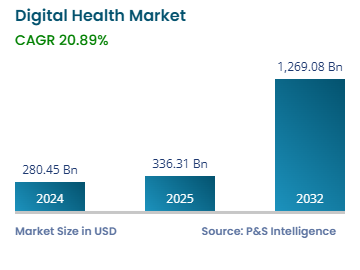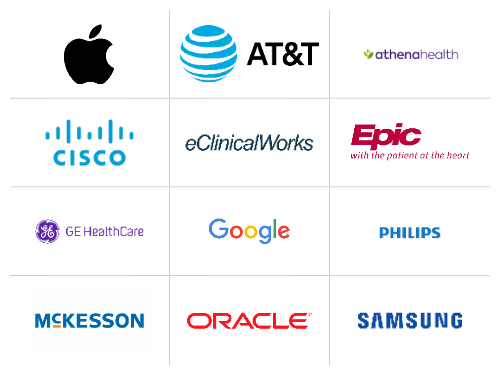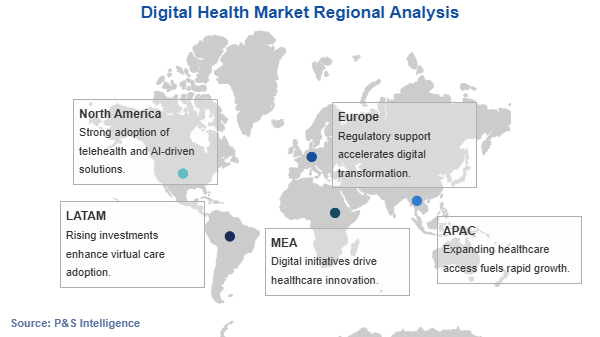Digital Health Market Analysis
The global digital health market is estimated to generate USD 280.45 billion in 2024, and it is expected to reach USD 1,269.08 billion by 2032, propelling at a rate of 20.89% between 2025 and 2032.
The market is being driven by the surging usage of tablets and smartphones, burgeoning demand for remote patient monitoring services, emergence of innovative mobile health (mHealth) applications, soaring requirement for advanced healthcare information systems, and implementation of supportive government policies regarding these solutions.
Moreover, enhanced internet connectivity with the introduction of 4G/5G, progression in healthcare IT infrastructure, increasing requirement to curb healthcare costs, increasing incidence of chronic diseases, and the growing accessibility of virtual care are few other major factors fueling the market growth.
The number of tablet and smartphone users grew from nearly 2.5 billion in 2016 to around 6.5 billion in 2021, and then, further to 4.88 billion in 2024, thereby causing a sharp surge in the industry revenue. Moreover, as per a European Union (EU) press release, smartphones or mobile phones are the most-heavily used devices for accessing the internet. With the rapid advancements in communication technologies, the demand for mHealth applications, including applications for fitness and health, is growing sharply across the globe.
IoT has become one of the most-prominent technologies in healthcare. It has evolved to the point where it is transforming the healthcare sector by facilitating various activities, such as efficiently tracking the staff, patients, and inventory; optimizing drug prescription; ensuring availability of critical medical equipment; and addressing chronic diseases. To provide an uninterrupted, tailored digital experience, big data plays a significant role in assisting a service provider in optimizing resources and time, in order to deliver superior healthcare services.
Another key factor fueling the market growth is the numerous initiatives taken around the world to make this concept popular. Many government organizations are implementing policies and taking strong measures, such as the provision of funds, for supporting the adoption of digital healthcare solutions. For example, the EU has announced an investment worth USD 10.3 billion (EUR 9.2 billion) for 2021–2027 for creating the Digital Europe program, to set up a regulatory framework that would facilitate the adoption of digital solutions in various operations, including those of the healthcare sector.
Telehealth services are high in demand because of the growing demand for reliable health and fitness monitoring, managing population in real-time, and secure healthcare information storage. The expansion of these services is being aided by the upgradation of the software and hardware used in telehealth. Thus, rising trend of software upgrades that include various healthcare applications is responsible for the market growth in coming years.
The development of variety of platforms for monitoring, diagnosis, and disease prevention will also be the main factor responsible for the growth of the market in coming years. Furthermore, increased expenditures in digital infrastructure, particularly in emerging nations, fuel market need for viable telehealth systems. New methods are also offered by the companies to provide services to their customers, which, in turn, fuels the market growth over the next few years.
The surging adoption of cloud computing solutions in healthcare settings is one of the trends currently being witnessed in the market. Because of the rapid advancements in storage and processing technologies, computing resources are becoming more powerful, easily available, and more affordable than before. This is subsequently fueling the development of cloud computing, a new computing model in which the resources, including both clinical applications, such as physician enquiries and pharmacy orders; and non-clinical applications, such as patient billing and revenue cycle management; are provided to users on demand, via the internet.





